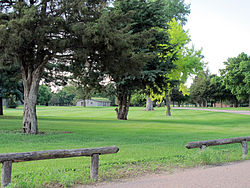Fort Kearney | |
 Restored Fort Kearny State Park | |
| Nearest city | Newark, Nebraska |
|---|---|
| Coordinates | 40°39′N 99°0′W / 40.650°N 99.000°W |
| Area | 80 acres (32 ha) |
| Built | 1848 |
| NRHP reference No. | 71000485 |
| Added to NRHP | July 2, 1971 |
Fort Kearny was a historic outpost of the United States Army founded in 1848 in the Western United States during the middle and late 19th century. The fort was named after Colonel and later General Stephen Watts Kearny.[1] The outpost was located along the Oregon Trail near Kearney, Nebraska. The town of Kearney took its name from the fort. The "e" was added to Kearny by postmen who consistently misspelled the town name.[2] A portion of the original site is preserved as Fort Kearny State Historical Park by the Nebraska Game and Parks Commission.[3]
The fort became the eastern anchor of the Great Platte River Road and thus an important military and civilian way station for 20 years. Wagon trains moving west, were able to resupply after completing about a sixth (16%) of the journey. The fort offered a safe resting area for the eastern immigrants in this new and hostile land. Livestock could be traded for fresh stock and letters sent back to the states. The fort continued to expand over the years, until there were over 30 buildings before its closure in 1871. It took on additional roles as a Pony Express station, an Overland Stage station and a telegraph station.[4]
- ^ Gannett, Henry (1905). The Origin of Certain Place Names in the United States. Department of the Interior. pp. 172.
- ^ Ellis, Mark (2006). Kearney. Arcadia Publishing. p. 7. ISBN 9780738541280.
- ^ Cite error: The named reference
ngpcwas invoked but never defined (see the help page). - ^ Comprehensive Management and Use Plan, Oregon National Historic Trail, Appendix III; Selected Historic Sites and Cross-Country Segments, Status and Recommendations; National Park Service, United States Department of the Interior; Washington, D.C.; August 1981; page 69-70

